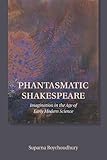Phantasmatic Shakespeare : Imagination in the Age of Early Modern Science / Suparna Roychoudhury.
Material type: TextPublisher: Ithaca, NY : Cornell University Press, [2018]Copyright date: ©2018Description: 1 online resource (248 p.) : 8 b&w halftonesContent type:
TextPublisher: Ithaca, NY : Cornell University Press, [2018]Copyright date: ©2018Description: 1 online resource (248 p.) : 8 b&w halftonesContent type: - 9781501726569
- Cognition in literature
- Imagination in literature
- Imagination -- History -- 16th century
- Imagination -- History -- 17th century
- Literature and science -- England -- History -- 16th century
- Literature and science -- England -- History -- 17th century
- Psychology in literature
- Science in literature
- History Of Science
- History
- Literary Studies
- LITERARY CRITICISM / Shakespeare
- Shakespeare, Renaissance theories of psychology, emerging fields of early modern science, imagination as a cognitive, exploits epistemological ferment
- 822.33 23
- PR3047 .R69 2018
- PR3047 .R69 2019
- online - DeGruyter
| Item type | Current library | Call number | URL | Status | Notes | Barcode | |
|---|---|---|---|---|---|---|---|
 eBook
eBook
|
Biblioteca "Angelicum" Pont. Univ. S.Tommaso d'Aquino Nuvola online | online - DeGruyter (Browse shelf(Opens below)) | Online access | Not for loan (Accesso limitato) | Accesso per gli utenti autorizzati / Access for authorized users | (dgr)9781501726569 |
Frontmatter -- Contents -- List of Illustrations -- Acknowledgments -- Introduction: Theseus, Phantasia, and the Scientific Renaissance -- Chapter 1. Between Heart and Eye Anatomies of Imagination in the Sonnets -- Chapter 2. Children of Fancy Academic Idleness and Love’s Labor’s Lost -- Chapter 3. Of Atoms, Air, and Insects: Mercutio’s Vain Fantasy -- Chapter 4. Seeming to See: King Lear’s Mental Optics -- Chapter 5. Melancholy, Ecstasy, Phantasma The Pathologies of Macbeth -- Chapter 6. Chimeras Natural History and the Shapes of The Tempest -- Epilogue The Rude Fantasticals -- Bibliography -- Index
restricted access online access with authorization star
http://purl.org/coar/access_right/c_16ec
Representations of the mind have a central place in Shakespeare’s artistic imagination, as we see in Bottom struggling to articulate his dream, Macbeth reaching for a dagger that is not there, and Prospero humbling his enemies with spectacular illusions. Phantasmatic Shakespeare examines the intersection between early modern literature and early modern understandings of the mind’s ability to perceive and imagine. Suparna Roychoudhury argues that Shakespeare’s portrayal of the imagination participates in sixteenth-century psychological discourse and reflects also how fields of anatomy, medicine, mathematics, and natural history jolted and reshaped conceptions of mentality. Although the new sciences did not displace the older psychology of phantasms, they inflected how Renaissance natural philosophers and physicians thought and wrote about the brain’s image-making faculty. The many hallucinations, illusions, and dreams scattered throughout Shakespeare’s works exploit this epistemological ferment, deriving their complexity from the ambiguities raised by early modern science.Phantasmatic Shakespeare considers aspects of imagination that were destabilized during Shakespeare’s period—its place in the brain; its legitimacy as a form of knowledge; its pathologies; its relation to matter, light, and nature—reading these in concert with canonical works such as King Lear, Macbeth, and The Tempest. Shakespeare, Roychoudhury shows, was influenced by paradigmatic epistemic shifts of his time, and he in turn demonstrated how the mysteries of cognition could be the subject of powerful art.
Mode of access: Internet via World Wide Web.
In English.
Description based on online resource; title from PDF title page (publisher's Web site, viewed 25. Jun 2024)


